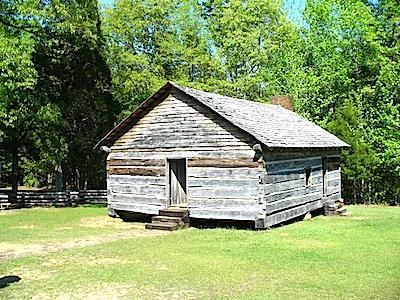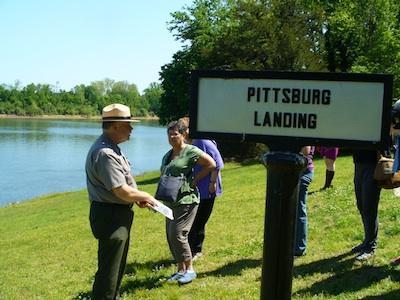
Reconstruction of Shiloh Church near the original site/David and Kay Scott
Over the years the two of us have visited numerous Civil War battlefields, memorials, monuments, and museums (sometimes referred to as 'the cannonball circuit'), but none better than Shiloh National Military Park.
The park in a rural area of southwest Tennessee is void of cell towers, heavy vehicle traffic, and nearby development. Shiloh is a world apart from better-known and much busier Gettysburg. It is a superb place to walk, bike, and simply linger during an exploration of the site of this important battle during the early part of America's Civil War.
We had visited Shiloh many years ago, and, although very little in the park appears to have changed, the most recent trip proved more informative, in large part because of a new 45-minute video that presents visitors with an overview of the battle. The excellent video debuted in the park's visitor center in 2012.
Another plus to the recent trip was commentary provided by NPS ranger Charles Spearman who accompanied our group on a tour of important sites within the park. Our visit lasted several hours, but a half-day would have been better. Visiting all of the park's important sites could easily consume an entire day.
Shiloh (Hebrew for 'the peaceful one') proved to be a crucial battle during the early stages of the Civil War. Following the capture of Confederate forts Henry and Donelson in early 1862, Union forces under General Ulysses Grant traveled up the Tennessee River with the goal of moving into the Mississippi Valley. This was to be accomplished by first capturing Corinth, Mississippi, a crucial Confederate transportation hub that connected Richmond, Virginia, with the war's western theater. It was in Corinth that Confederate General Albert Sidney Johnson chose to assemble forces and mount a counter-offensive designed to stop Grant's advance.
Grant's forces landed in March 1862 at Pittsburg Landing, a small community on the Tennessee River where the general was ordered to establish a base and wait for reinforcements. The landing was a short distance from Shiloh Church, after which the battle would be named. With knowledge of Grant's encampment, Confederate General Johnston decided to surprise the 40,000-strong Union force with his own army of 44,000 men. Unfortunately for the Confederates, Johnston's 22-mile march from Corinth to Pittsburg Landing was delayed by bad weather, poor roads, and confusion among his officers. The delay would prove of crucial importance in the battle to come because it allowed substantial Union reinforcements to reach the area.

NPS Ranger Charles Spearman provides interpretation for park visitors at the location where Grant's troops landed/David and Kay Scott
When the Confederate force was discovered prematurely by a Union patrol, the surprise attack was foiled, and some thought was given by the Confederates to returning to Corinth. Johnston's desire to attack prevailed, however, and the Confederate force continued east. Battles ensued over two days, with Confederate forces dominating in the initial stages during which 2,200 Union troops were captured. This proved to be the high point of the battle for the Confederates. The tide turned on the second day when Grant received reinforcements and Confederate forces were forced to withdraw back to Corinth.
Overall, the two-day battle resulted in nearly 24,000 casualties. Another 8,000 casualties would result from the subsequent battles in and around nearby Corinth. Historians have pondered whether Confederate forces would have more likely prevailed had favorable weather permitted the attack to occur on schedule, several days prior to the arrival of Union reinforcements. Another unknown is how the battle might have been altered had Confederate General Johnston not died during the first day of battle.
Throughout our tour of the grounds Ranger Sherman offered perspectives on the timeline of the battle and how officers on each side reacted as the conflict progressed.
Shiloh National Military Park has 12 ½ miles of paved roads that provide vehicle access to 20 important sites throughout the park. The Shiloh Church has been reconstructed near its original site based on a soldier's drawing. CDs available for purchase in the visitor center provide commentary for a self-guided auto tour of the park. The military park also includes a separate section with an interpretive center in Corinth, Mississippi.



Add comment